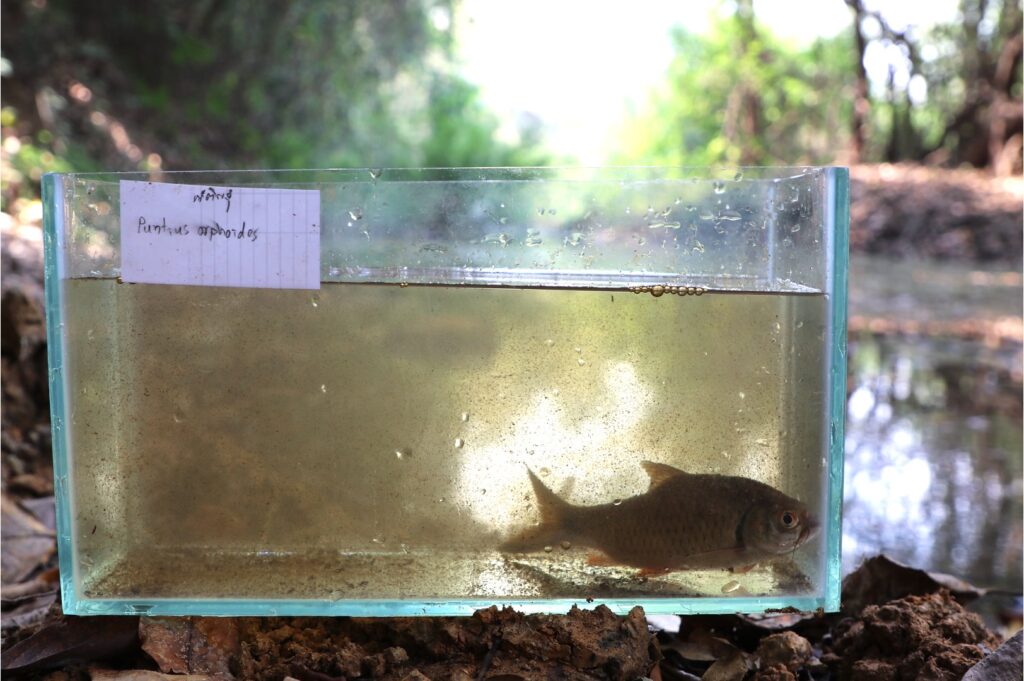Monday August 22, 2022

Tropical rivers are among the most biodiverse ecosystems on the planet, but are challenging to study. Identifying targets for biodiversity conservation and monitoring the impacts of current threats, such as land use change, overfishing, pollution, climate change, and invasive species, requires data on patterns of aquatic diversity in these rivers. However, due to their large size and a lack of funding, biodiversity in tropical rivers has remained largely understudied. In addition, collecting data on aquatic species richness and distribution over large areas using traditional fish sampling methods is an expensive and logistically daunting task. Fortunately, environmental DNA, or eDNA, has the potential to gather the data necessary to identify patterns in biodiversity far more efficiently. This potential was recently demonstrated in Thailand’s Chao Phraya watershed, where researchers collected water samples across the basin and analyzed the eDNA that fish had shed into the environment. Their paper in the journal Scientific Reports (Blackman et al. 2021) demonstrates the power of this approach, and lays out a framework that may be replicated in other tropical river basins.
The limited biodiversity data previously available from the middle and lower reaches of the Chao Phraya watershed showed that many fish species living there are threatened and endemic – meaning they occur nowhere else in the world. The river, like many in Southeast Asia, is facing increasing pressure from human-driven changes, and few surveys have occurred there. Having a field crew sample this massive watershed with traditional methods like nets would be a mammoth undertaking, but eDNA metabarcoding offers a more efficient solution. Metabarcoding is a methodology in which filtered water samples are analyzed to detect the eDNA of many species at the same time, and it has already been shown to have major potential to monitor biodiversity on a large scale. However, its use in tropical systems has been more limited to date. In an effort to demonstrate its utility in highly diverse, understudied tropical systems, the authors of this study collected 234 eDNA samples from 39 sites throughout the Chao Phraya basin and performed a metabarcoding analysis.
The researchers collected six samples at each sample site, which ranged from the headwaters in northern Thailand to the river’s mouth in the Gulf of Thailand. For each sample, they filtered 100 milliliters of river water through a collection filter, then took these filters back to the laboratory where they extracted DNA from the samples and analyzed it using two different primers. Primers are molecular markers that bind to specific segments of DNA and allow them to be amplified, and these amplified sequences can then be used to identify the species that the DNA belongs to. In total, the analyses detected 108 different fish taxa, and local richness at each of their sample sites ranged from 13–52 taxa. Showing that eDNA is capable of detecting this diversity is interesting in and of itself, but the true value of this study came from its statistical analysis. By examining local and among-community diversity patterns, the researchers were able to cluster the fish diversity of the basin into unique groups, revealing a separation between the fish community in the northeast from that of the southwest portion of the watershed. Further subdivision was also detected in the northeast, providing more nuanced insight into the underlying fish communities in that region.
Accurate and up-to-date data on biodiversity patterns at the landscape scale are critical for informing evidence-based conservation approaches. Such data are currently lacking for many tropical rivers, but this study demonstrates that eDNA metabarcoding may provide a means of filling these gaps. The analysis suggests that the headwaters of the Chao Phraya, though lower in overall diversity, is home to a fish community that is distinct from that in the lower river, suggesting that sites in both portions of the watershed should be prioritized for conservation. Environmental DNA is not perfect, and is limited by incomplete genetic reference libraries, but the ability to rapidly and inexpensively sample at a landscape scale represents a significant strength, particularly in understudied areas like the tropics. By dividing a watershed into priority zones that capture the greatest proportion of total biodiversity, managers can focus their efforts for maximum impact. FISHBIO is currently leading a new effort as part of the Wonders of the Mekong project using eDNA to survey freshwater fish diversity in Cambodia. As genetic libraries continue to improve, eDNA will only become more powerful in its ability to provide insight into patterns in biodiversity, and it will be critical to harness this potential to help conserve the diversity of life around the world.
